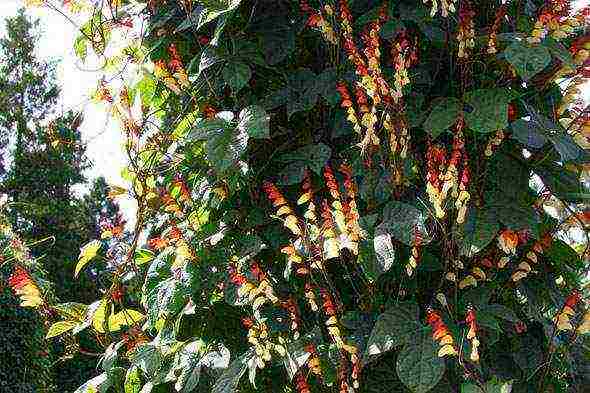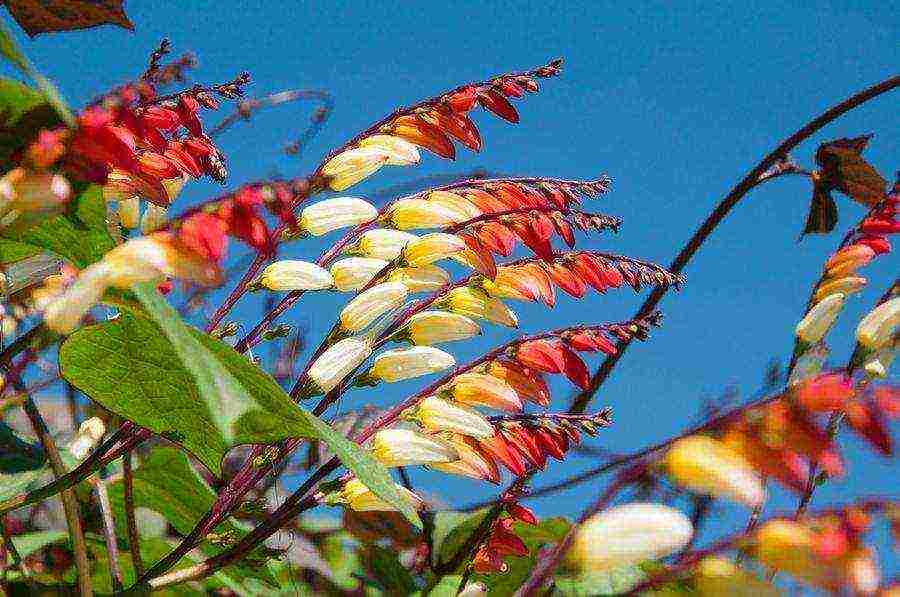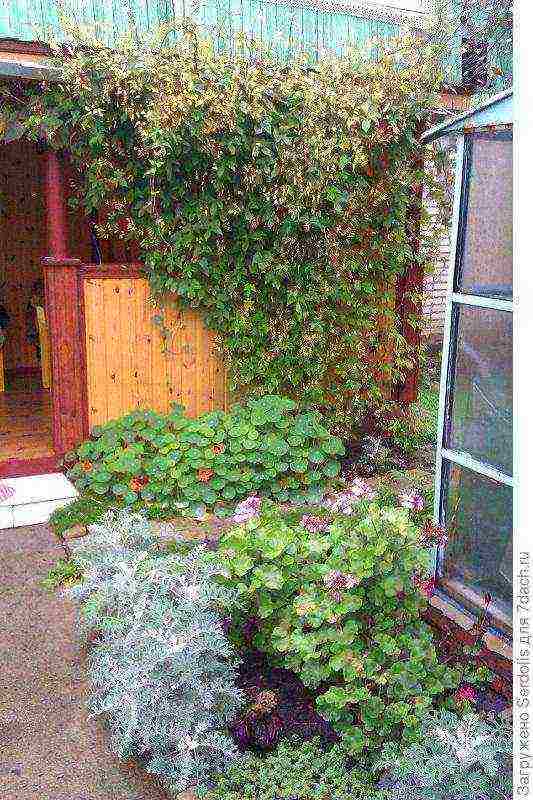Content
Lobata mine (mine lobata) is a variety of the morning glory flower, a densely growing liana, which is loved by Russian gardeners. Representatives of this type of plants are able to give a decorative look to any unsightly support in a short time - a fence, gates, and even bushes. In addition, any morning glory is capable of surprising not only with the bizarre shape of the leaves of the green crown, but also with abundant large-flowered flowering.
Description
The lobed mine appeared to the world from Mexico, where for many centuries it has been growing as a wild perennial plant. In our climatic conditions, liana is grown as an annual. Powerful lashes can reach a length of 3 to 6 meters, and flowering can continue from the beginning of July until the onset of real autumn frosts.

The flowers resemble a spikelet with a three-color design - shades of white, orange and red. Formed, blooming liana imitates flames, creating an indelible impression even with a sophisticated grower.
Growing methods in the Moscow region
Like many annuals, the blade mine is grown in seedlings. Sowing seeds in open ground is also possible, but in this case, the flowering of the vine will be postponed to the end of the season.
The seeds of a mine, like any morning glory, should be stratified. For this, the planting material is placed in water at room temperature for a day. If desired, nutritious fertilizers are added to the water, for example, "Bud". After a day, high-quality planting material should swell. Those seeds that have not changed their external state are pierced with a needle and left in solution for another day.
Swollen seeds are planted in a nutritious soil, paying attention to the depth of the container. Since morning glory has a rod-shaped root system, and picking seedlings that have hatched can significantly damage it, the cage should be carried out in cups at least 10 cm deep.
The planting depth is 1 cm, and 2-3 seeds are placed in each planting hole. The containers are moistened and covered with cling film.
The first shoots should appear after the second week after planting. When the seedlings reach the stage of appearance of the third and subsequent leaves, you should take care of additional support, allowing young plants to continue their growth without the threat of entanglement of the growing shoots. A similar support can be wooden sticks, or just pencils, located 2-3 cm from the point of growth of the stem.
Preparing the land for planting
When looking for a site suitable for planting morning glory, you should opt for a sunny location that is sufficiently protected from strong gusts of wind. The wind is able to break the fragile, fragile shoots of the plant. Planting in partial shade is possible, but insufficient natural sunlight affects the quality of flowering.
Mine lobata is demanding on the level of soil nutrition, therefore, before planting seedlings in the ground, you should take care of meeting this condition. Site preparation consists in the mandatory introduction of complex fertilizers, as well as humus, sand and mulch in order to obtain breathable, loose soil. Since the plant has a tap root system, there is a danger of the proximity of groundwater.

The best neighbors for mine lobata are related representatives of the same family of vines. The most appropriate are combinations of different varieties of morning glory with contrasting shades of flowering.Planting is also possible using natural supports - a lilac bush, for example. So, after its own flowering, the lilac will delight the eye of the summer resident, being entangled in a garland of fancy shades of large morning glory flowers.
Landing in the ground
Transplanting mine seedlings to their permanent habitat is carried out at the beginning of June and requires special care. This is due to the vulnerable root system, damage to which can provoke the death of a young seedling. If the seeds were sown in peat pots, then there are no problems with replanting. In other cases, the transfer of the seedling should be carried out together with an earthen clod.
In the prepared ridge, holes are dug, the depth of which should be several centimeters more than the height of the seedling container.
The holes should be at a distance of 20 - 25 cm from each other. Pre-hydration is beneficial.
After planting the seedlings, the ridge is abundantly watered with settled water at atmospheric temperature.
Care
Like any morning glory, mine lobata requires the attentive attitude of the summer resident. The soil should be regularly moistened and loosened, weeds should be removed as they appear. Top dressing consists in the regular application of fertilizers containing nitrogen - at least once a week.
Ipomoea is the most demanding of a support, which must be strong enough to withstand the weight of heavy, overgrown lianas.
The width of the support should correspond to the width of the canvas that the plant forms.
Pests and diseases
Failure to comply with agricultural technology, morning glory threatens a number of unpleasant consequences. First of all, excessive watering or stagnation of water with insufficient drainage provokes the development of fungal diseases that are dangerous for immature, recently planted seedlings - black leg, rot.

With excessively frequent planting, thickening of plants, lianas are threatened by attacks of insect pests:
- Aphid. The emergence of a population of a sucking-gnawing insect is accompanied by yellowing of the leaves, their deformation and falling off. Insect reproduction occurs rapidly, therefore, at the first signs of damage, plants should be treated with a specialized insecticide, with re-treatment after a week.
- Spider mite. If a thin, almost transparent white bloom is found on the leaves, the green mass of the vine should be sprayed with cold water. With further growth of spots, the vines should be treated with a solution of copper sulfate.
Preparing for winter
At the onset of autumn, the one-year-old vine is removed from the support and disposed of.
If the morning glory began to bloom by mid-July, then it has mature pods containing seeds. Several shoots are cut off and placed in a dry, warm room for further ripening and drying. Dried pods open easily and reveal ready-made planting material, suitable for the next spring planting. The seeds are placed in a paper envelope or tissue bag and stored in a dark, dry place.
Mine flower is an annual liana. Draws attention with the color range and shape of the flowers. To grow a strong and developed plant, you need to carefully read the principles of caring for it.
Description of "bladed mines"
Liana is also known as “morning glory mine lobata”. Her homeland is Mexico. In warm climates, it grows as a perennial crop. Got spread thanks to unusual inflorescences, consisting of graceful flowers.

The flower "mine" is suitable for decorating plots and balconies
Distinctive features of the mine:
- curly red stems 6 m long;
- openwork lobed leaves of light green shades;
- long flowering - from July to the first frost;
- inflorescence up to 0.4 m long in shape resembles a spikelet, and the flowers are a drop;
- the flowers are closed at first; when they open, pistils and stamens are shown. Their color range changes depending on the degree of blooming: from raspberry to orange.
Creating the right growing conditions allows you to decorate your garden, gazebo or balcony with a beautiful liana.
Blade mine: growing from seeds and care
The flower is propagated using seeds. They are placed in prepared soil containing nutrients. Purchased flower soil is suitable for this. Sowing is recommended at the end of the winter period.
The landing procedure is as follows:
- soaking the seeds in a germinating liquid;
- landing in moist soil to a depth of 1 cm;
- creating a greenhouse by covering the pot with glass or transparent film.
After half a month, the first shoots appear, which are planted in 3 plants in individual containers with a volume of up to 2 liters. A support is also provided to which the vine is tied for growth.
This is the final design of the plant. The "mine" does not tolerate the transplant, because the root system is injured. The pot is placed in a well-lit area, direct sunlight does not harm the plant. The temperature regime in the summer should be more than +20 ° С, in winter the flower withstands a drop in temperature to +10 ° С.
For morning glory, water it regularly and abundantly to keep the soil from drying out. In dry weather, spray additionally with a sprayer. For the formation of dense greenery and abundant flowering, apply complex fertilizers 2 times a month.
A beautiful annual requires constant attention. But all efforts to grow are rewarded in the end with bright flowering.
See also: caring for room hydrangea
Over the years, I have used a variety of bindweed to decorate the walls and arches in my garden. These are kobea and morning glory of different varieties. But I especially liked such an unusual bindweed as Mina Lobata. I bought seeds like Ipomoea "Tinker Bell". The Latin name for this plant is Quamoclit Lobata. This liana, like all morning glories, rises along the support to a height of up to three meters.
To get an earlier flowering, I grow a loach through seedlings. Better to plant in peat pots, because the sprouts are not very fond of transplanting. Pre-soaked seeds germinate on the third day. After germination, the plant releases a tendril, I immediately tie it to a peg so that it does not break during transportation. This bindweed does not require special care. It is only necessary to direct and tie to the support when landing in the ground. The plant is very fond of the sun, nutritious soil and moderate watering.
As the vine grows, it pleases with unusual carved leaves. In all its glory, the bindweed appears at the end of July-August, flowering continues until the very frost. The flowers of this plant look like small bananas 2 cm long and change color as they bloom, like a chameleon. First red, then orange, then yellow and finally white. It so happens that in one inflorescence there are flowers of different colors.
The multicolored inflorescences of the Mina Lobata creeper go well with orange nasturtiums, yellow marigolds and other brightly colored flowers in my garden.

Mina and marigolds
Shading the veranda I think you will love a wonderful bindweed like Mina Lobata! I advise all our seven-day workers to grow this unpretentious and original climbing plant in their garden.
author Kotarova I.N., photo by the author
Flower experiments take place in my garden every year. Of the many ornamental plants grown, several flowering species or varieties that are especially pleasing to the eye stand out.
Sometimes these are quite common plants, but it is in a given year that they show outstanding results. For example, those planted in the best place for them - grown in such suitable conditions that as a result they were able to fully demonstrate all their wonderful qualities. Such highly decorative plants become the highlight of the whole garden. You walk past them and every time you think: “Good! Oh, good! "
I think that flower growers understand me 🙂
In the last gardening season (2013), one of such wonderful plants for me was the liana Mina Lobata - an original loach with very special flowers.
I want to share my experience of growing this rare plant and the joy of contemplating it with the florists of the site.
My experience of growing vines Mina Lobata
Liana Mina Lobata was not new to me. Earlier I met (in the USA) thickets of this vine. Then she also impressed me, but not very much.
A completely different effect is from admiring the blooming liana Mina Lobata in her garden.
How did Mina Lobata, grown by her own hands, please me?
I'll tell you everything in order.
In March, I planted several seeds of Mina Lobat creeper on seedlings. They rose together, but through my fault most of the seedlings died. Only two plants survived, which soon turned into pretty seedlings.
The soil in my garden is sandy, but the soil is ennobled (with humus, peat, rotted manure) with the addition of mineral fertilizers that are usual for the season.
I walked around the garden for a long time, deciding where it would be better to attach vine seedlings based on the needs of this plant.
Liana Mina Lobata prefers nutritious soil and a sunny, windless place. But by the time her seedlings were planted in the garden, all suitable places were already taken.
Then I decided to plant them next to a growing lilac bush, which became a reliable natural support for the vine shoots.
Mina Lobata's seedlings liked the space provided. They deftly clung to the trunk of the lilac, climbed up on it and then ran higher and higher along its branches.
The leaves of the Mina Lobat creeper are pretty, and are infrequently located. Therefore, they did not greatly interfere with the lilac and even decorated it, having a different shape and color.
Blooming creeper Mina Lobata
My Mina Lobata bloomed already at the end of July, throwing out unusually long (compared to other vines), hard, maroon flower-stalks. The length of the amazing vine inflorescences reached 15-25 cm, they were covered with red buds.
Over time, the opened flowers on the tassel acquired orange, yellow and cream color, while increasing somewhat in size. And the higher-placed flowers in the inflorescence remained red. Therefore, at the same time, on each tassel, flowers of different colors were arranged in a row: almost white, yellow, orange and red ...
Anyone who has not yet seen how the Mina Lobata liana blooms is very surprised to see variously colored flowers nearby.
It turned out that the multi-colored inflorescences of the Mina Lobata vine go well with yellow-red rudbeckia and golden heleniums, with other brightly colored flowers in my garden.
The growing seedlings of the creeper Mina Lobata, having thrown out a lot of side shoots, soon reached the top of the lilac. I didn't want to add a long support stick for them, so as not to spoil the natural look of this composition. Therefore, I decided: let it be as it turns out ...
My Mina Lobata continued to grow and bloom, scattering new shoots in all directions. Finding no support for which they could catch on, the shoots "hovered" around the lilac bush, creating an openwork frame around. It looked adorable!
As is usually the case in a mass planting, there were few inflorescences on the vines, but they did not block each other, but seemed to float in the air!
In addition, liana Mina Lobata blooms for a long time, while quietly throwing off individual faded parts from the inflorescences-tassels, which does not violate the beauty of the whole plant. And new inflorescences regularly appear on the shoots of this vine.
Even falling under the continuous autumn rains this year, the liana Mina Lobata did not give up. When the sun appeared, she continued to delight the eye with her wonderful flowering.
Vine inflorescences Mina Lobata in a bouquet
I was afraid that my beautiful liana Mina Lobata would die from prolonged cold rains, and therefore tore off some of the inflorescences from her before the weather worsened. They break off easily at the brush attachment points.
It turned out that the inflorescences of the Mina Lobat liana stand perfectly in a bunch, retaining their decorative effect for a long time.
I gave such cute colorful bouquets to many of my friends. None of them were familiar with this vine, so they were surprised and delighted with such unusual, bright flowers of Mina Lobata.
I advise the site's florists to grow this unpretentious and original climbing plant in their garden. There are no difficulties, and you will certainly like the flowering liana Mina Lobata!
Irina Nikolaevna Kotarova (Moscow)
"Floriculture: Pleasure and Benefit"
All about vines on the site
Garden world on the
Everything about gardening on the website


